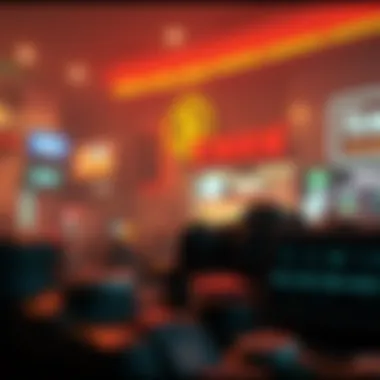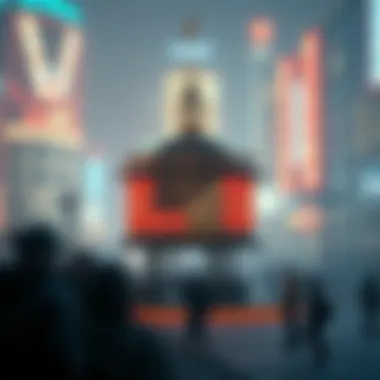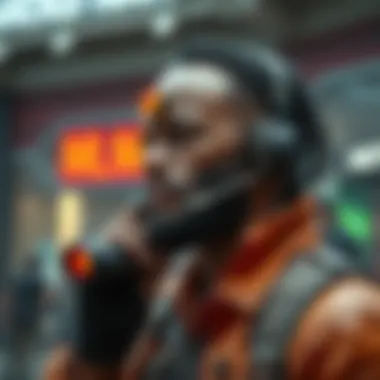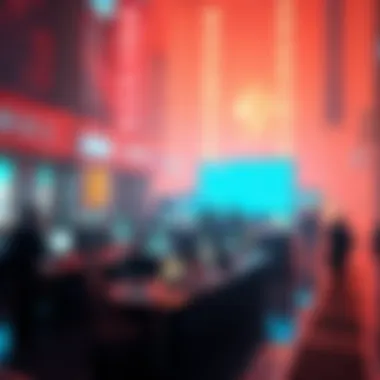Affordable NFT Art: Trends and Insights in Digital Creations


Intro
In the ever-evolving landscape of digital art, affordable NFT art has emerged as a captivating phenomenon that’s stacking up attention from both seasoned collectors and curious newcomers. It's not just noise; it's a tangible shift in how art is valued and traded, bringing a vast array of options to the forefront. Grasping the nuances behind this trend is imperative for anyone looking to navigate the intertwining worlds of cryptocurrency and art.
As digital art takes center stage, the rise of low-cost NFTs has sparked a discussion around accessibility, integrity, and the sustainability of the marketplace. This article will break down the essentials—starting from the basics of cryptocurrency, leading into market dynamics, and concluding with the implications of these economic changes. By peeling back the layers, we aim to offer a clearer illustration of what affordable NFT art signifies in today's society.
The journey through affordable NFT art isn’t just about grabbing a pretty picture at a low price. It's about understanding the technology driving these assets, recognizing the various platforms that facilitate their trade, and discerning the economic ramifications of hosting a digital art piece at a bargain.
Let's put on our explorer’s hats and delve deeper into this burgeoning realm.
Understanding NFT Art
In a landscape where digital and physical realms continuously intertwine, grasping the nuances of NFT Art becomes essential. The term NFT, or Non-Fungible Token, refers to a unique digital asset representing ownership of a specific item, often associated with artwork. This level of individualization not only underscores the authenticity of digital works but also creates exciting opportunities for artists and collectors alike.
Understanding the fundamental concept of NFT Art is crucial for anyone engaged in the market, be it investors, traders, or tech enthusiasts. As interest in digital art surges, mastering the basics allows individuals to navigate the complexities of ownership and value.
Defining Non-Fungible Tokens
Non-fungible tokens are digital certificates of ownership that exist on blockchain technology, primarily Ethereum. Unlike cryptocurrencies such as Bitcoin, NFTs cannot be exchanged on a one-to-one basis because each token is unique. To put it simply, just like a rare trading card or a limited-edition collectible, non-fungible tokens carry specific attributes making them distinct.
This uniqueness lends itself to a multitude of applications, particularly in art. Artists can create digital works that are verifiably scarce, altering how we perceive authorship and ownership in the digital age. Some artists like Beeple have famously sold digital pieces for millions, illustrating the potential financial rewards.
The Evolution of Digital Art
The journey of digital art has been dynamic, beginning in the late '90s when artists first explored computer-generated images. Over the years, these creations gained acknowledgment from traditional art circles, yet they often faced skepticism regarding their legitimacy. It wasn't until the rise of NFTs that digital art found its footing in mainstream conversations.
With platforms like SuperRare and Foundation emerging, digital artists now have the means to sell their work directly to collectors, bypassing traditional gallery systems. The integration of blockchain technology has solved many issues surrounding piracy and ownership, making artists more empowered than ever. Essentially, we are witnessing an artistic renaissance, moving this medium from the backseat to the driver’s seat of art appreciation.
NFT Art vs. Traditional Art
When comparing NFT art to traditional forms, the differences abound. Traditional art often exists in physical forms — paintings, sculptures, or installations — that can be touched and displayed in real spaces. Conversely, NFT art transcends materiality, existing solely in a digital framework.
Here are some notable distinctions that shape the dialogue:
- Accessibility: NFT art can reach a global audience instantly through online platforms, whereas physical art often relies on local galleries or exhibitions.
- Ownership Transfer: The transfer process of ownership for NFT art is seamless and recorded permanently, while traditional art ownership is usually documented through contracts and sales receipts.
- Market Dynamics: The value of traditional art can be subjective and differs based on prestige, artist reputation, and market demand. In contrast, NFT art values can fluctuate based on trends and speculation, creating a more volatile environment for investors.
"NFTs empower creators and collectors by introducing a novel approach to ownership, thus redefining artistic markets."
Therefore, understanding these dynamics not only illuminates the current trends but also sets the stage for future developments in the art world as the line between reality and digital continues to blur.
Market Dynamics of Affordable NFTs
Examining the market dynamics surrounding affordable NFTs provides a deep lens into the shifting landscape of digital art. The rising tide of budget-friendly NFTs proves to be more than just a trend; it reflects a profound transformation in how art is bought and sold in the age of technology. As barriers come down, accessibility rises and opens doors for a new demographic of collectors, artists, and investors alike. Understanding these dynamics helps chart a course through the sometimes murky waters of pricing, buying behaviors, and market trends.
The Surge of Budget-Friendly NFTs
The spike in inexpensive NFTs can largely be attributed to the democratization of art. Small-time creators are taking to platforms that welcome lower price points, thus broadening their audience. When you think about it, art being available at prices that mere months ago seemed impossible is quite the sight to behold. This shift invites both new collectors and seasoned buyers to dip their toes in the waters of digital art.
Moreover, artists now express their creativity without the fear of steep entry costs. Think of platforms like OpenSea where the prices of artworks can range from pocket change to staggering sums. This diversity in price points enriches the marketplace, as it becomes a melting pot of talent and vision.
Price Influences and Trends


The pricing of NFTs operates on various factors ranging from the inherent quality of art to current market demand. It's not unlike the stock market; a piece can skyrocket in value overnight based on social media buzz or collector interest. For example, speculative buying can drive prices up, but it's vital to approach this phenomenon with a discerning eye.
Additionally, limited releases and collaborations can create hype. A sudden surge in a particular artist can set a chain reaction in motion, causing their artworks to attain prices that may seem disconnected from their initial worth. Understanding these trends can provide insightful clues for buyers looking to make informed decisions.
Marketplace Comparisons
OpenSea
OpenSea stands tall as a formidable player in the NFT marketplace arena. With a vast inventory of affordable digital collectibles, it offers something for everyone. One key characteristic of OpenSea is its user-centric design, making navigation intuitive for both seasoned art enthusiasts and newcomers alike.
A unique feature is its support for multiple cryptocurrencies, allowing buyers to engage in various ways. However, lower-priced NFTs can sometimes exist amid a sea of low-quality works, causing potential buyers to tread cautiously.
Rarible
On the other hand, Rarible emphasizes community governance. This decentralized platform allows users to partake in decision-making, making it an engaging choice for the community-oriented collector. Its key characteristic is the ability to earn rewards through participation, especially appealing for those looking to engage more deeply within the NFT ecosystem.
Rarible's unique feature lies in its "RARI" token which can be earned by buying, selling, or creating art. As for downsides, its user interface can feel daunting to those who are not tech-savvy, but for others, this complexity presents a learning curve that can yield rich rewards.
Mintable
Mintable is more beginner-friendly, focusing on tools that simplify the creation of NFTs. An appealing aspect is the ease with which new artists can start their journey in the NFT space. Its key characteristic is the user-friendly minting process that requires no coding whatsoever.
A standout feature of Mintable is the “gasless" minting option, making it less costly to list artworks. Still, buyers should recognize that being beginner-friendly might also draw in lesser-quality pieces that could saturate the market.
Exploring these marketplaces reveals that while affordability is significant, the market dynamics extend beyond mere pricing. The landscape is diverse, nuanced, and continually evolving, mirroring broader cultural shifts towards digital ownership and artistic expression.
Creators Behind Cheap NFT Art
In the vast, evolving landscape of affordable NFT art, the creators themselves are the lifeblood of this burgeoning ecosystem. Understanding who these creators are—and what drives them—adds depth to the discussion around accessibility and evolving trends. Emerging artists and established figures alike play pivotal roles in fostering a diverse artistic environment that pressures both quality and quantity at affordable prices.
Emerging Artists and Their Motivations
Emerging artists bring fresh perspectives and creativity to the table, often fueled by a desire for self-expression and financial opportunity. For many, traditional avenues for showcasing art can be daunting, involving gatekeepers like galleries and curatorial selections. With the entry of NFTs, they find a platform that doesn’t discriminate based on established norms in the art world.
The motivations behind creating affordable NFT art often stem from:
- Financial Accessibility: Many believe in making art available to everyone, helping to dismantle elitist structures in the art market.
- Self-Promotion and Visibility: The digital marketplace allows newcomers to build their personal brand without relying on others’ endorsement.
- Experimentation: The relatively low cost of minting NFTs enables artists to try out various styles and concepts without the fear of financial loss.
A dedicated new artist might say: "Sometimes, it’s not about making money but simply getting your name out there." Consequently, the community rallies around those willing to take risks and innovate.
The Role of Established Artists in Accessibility
While emerging artists are the steam behind the affordable NFT movement, established artists also wield immense influence. Their involvement can elevate the overall discourse on value and quality within the market, introducing new collectors to affordable art without sacrificing artistic merit.
Established artists often engage with affordable NFTs for several reasons:
- Support for Peers: Many well-known artists recognize the importance of nurturing the next generation. By creating lower-priced works, they create a pathway for aspiring talents.
- Market Experimentation: Just as emerging artists experiment, established names want to explore different mediums and technologies without the overhead that comes with traditional art sales.
- Building Community: Collaborations that feature both emerging and established artists can forge communal bonds and generate buzz, driving interest in affordable pieces.
This merging of experience and fresh talent often produces a rich tapestry of creativity, invigorating the market and broadening the audience for affordable art.
Collaboration in the Digital Space
Collaboration is a hallmark of the digital art space and one that encourages both innovation and democratization of creativity. Artists often team up across various platforms and styles to create multi-dimensional works that engage consumers in unique ways.


Key benefits of such collaborations include:
- Cross-Pollination of Ideas: Different perspectives result in groundbreaking concepts that may not have emerged in isolation. Think of a street artist pairing with a digital creator to present a mixed-media NFT.
- Shared Audiences: By working together, artists can tap into each other's fan bases, expanding their reach and enhancing visibility for affordable art.
- Resource Sharing: Collaborative efforts often lead to cost-sharing for minting and marketing, enabling more artists to participate in the NFT ecosystem without breaking the bank.
As some would say, "Two heads are better than one. "The emergence of collaborative projects underscores the significance of community within the NFT world, enriching the context in which affordable art is produced and celebrated.
Ultimately, the creators behind cheap NFT art not only ensure a dynamic economy but also inspire conversations about art's future, accessibility, and the communal nature of creativity in the digital age.
Affordability vs. Quality in NFT Art
In the buzzing world of NFTs, the conversation often pivots around two key concepts: affordability and quality. Understanding how these two aspects intertwine is crucial for buyers, artists, and investors alike. The dynamic interplay between price and artistic merit can significantly shape purchasing decisions in the burgeoning marketplace of inexpensive digital artworks. As affordable NFT art continues to gain traction, discerning the balance between what one pays and the visual or conceptual richness of what they receive becomes paramount.
Navigating the Quality Spectrum
The quality of affordable NFT art is not a monolithic concept. Rather, it exists on a vast spectrum that ranges from simplistic digital sketches to intricate, high-resolution masterpieces. One might first think that lower prices equate to lower quality, but this is a misunderstanding. For instance, an artist's decision to sell an NFT art piece at a low price could stem from a desire to reach a wider audience or encourage the appreciation of their work in an often elitist space.
Many emerging talents utilize platforms like Rarible to showcase their creativity without the heavy overhead of traditional galleries. This accessibility has birthed a generation of art that, while affordable, still captures the essence of artistic expression. It's not uncommon to find pieces that resonate with viewers on deeper levels, regardless of their price tag.
To navigate this quality spectrum effectively, collectors could adopt a few strategies:
- Research Artists: Investigate the backgrounds and motivations of the artists, as a deeper understanding can enhance appreciation and trust in their works.
- Analyze Marketplace Trends: Understand how specific genres or styles are valued in different marketplaces. For example, collectibles may fetch lower prices due to their novelty but can still hold immense sentimental or cultural value.
Understanding Artistic Value
Artistic value transcends mere visual appeal; it embodies the thoughts, emotions, and culture that an artist encapsulates in their work. The understanding of this value becomes even more nuanced within the arena of affordable NFTs. Buyers need a keen eye to distinguish between the sheer novelty of a piece and its enduring significance. Just because an artwork is inexpensive doesn’t necessarily mean it lacks depth or substance.
For example, consider the role of storytelling in art. An NFT that tells a compelling narrative may attract more interest and value than a flashy piece that lacks context. Engaging with an artist's process—whether through social media platforms, artist statements, or interviews—can provide insight into the context of their work, elevating a collector's understanding of its inherent worth. Purchasing an NFT becomes more than a transaction; it evolves into an investment in an artist's vision and philosophy.
Buyer Sentiments Regarding Value
With the recent boom in the market for affordable NFT art, buyer perceptions surrounding value are rapidly evolving. It seems like sentiments are mixed, where some buyers chase the high of purchasing low-budget pieces as collectors, while others seek to flip them for profit. The emotional engagement with art plays a significant role in how buyers evaluate value, particularly when buying at lower price points.
For some, the thrill derived from acquiring a unique piece at a modest price can be exhilarating. A survey conducted on platforms like Reddit showed a wide array of opinions, with many buyers emphasizing the emotional connection they feel towards their affordable acquisitions over their market profitability. Buyers often indicate that the joy of ownership and the recognition of supporting emerging artists outweighs concerns about investment potential.
In summary, the consideration of affordability and quality within NFT art encompasses much more than simple price tags or aesthetic appeal. It calls for deeper engagement, personal reflection, and a willingness to explore the stories behind each piece.
"Art is not what you see, but what you make others see." - Edgar Degas
As we continue to navigate this virtual art phenomenon, recognizing these dimensions becomes essential for making informed purchasing decisions.
Legal and Ethical Considerations
In recent times, the emergence of affordable NFT art has not only democratized access to digital ownership but has also ushered in a host of legal and ethical dilemmas. As the NFT market continues flourishing, understanding the legal frameworks and ethical responsibilities involved has become paramount for artists, collectors and platform operators alike. Without such awareness, the risk of legal disputes, fraud, and reputational damage looms large.
Copyright Issues in the NFT Space
One of the most pressing legal concerns within the NFT art sector is copyright. The very core of copyright law is to safeguard the interests of creators while granting them the ability to monetize their works. However, the NFT space operates in a gray area. Essentially, when purchasing an NFT, the buyer acquires ownership of a digital file but does not necessarily own the copyright to the artwork itself.
"An NFT can be seen as a unique digital certificate, but ownership does not equate to intellectual property rights."
This situation can lead to misunderstandings where buyers believe they have the right to reproduce or commercialize the art, only to find out that they do not. It's crucial for both buyers and sellers to delineate these rights clearly in the sales agreements, possibly even including licensing agreements to avoid future conflicts. Further, platforms like OpenSea and Rarible must strive to establish clear guidelines regarding copyright to protect creators from unauthorized usage of their works.
Authenticity and Provenance


Within the thriving NFT art market, the notion of authenticity is everything. Unlike traditional art, where provenance or history can sometimes be difficult to establish, the blockchain technology underpinning NFTs offers a robust solution. Each piece of digital art is linked to a unique token which includes its transaction history, thereby providing a clear lineage from creator to current owner.
However, the demand for affordable art can lead to a surge in forgery or the selling of works under false pretenses. As a buyer, verifying authenticity becomes paramount. This goes beyond checking if the NFT is listed on a reputable marketplace; it often involves researching the artist and their prior works. Potential buyers should also be vigilant about the platform's mechanisms for reporting and dealing with fraudulent activities, as a solid system will better ensure the protection of their investments.
Responsibilities of Art Creators
The responsibilities lying on the shoulders of art creators in this space cannot be understated. They are not just artists; they are participants in a complex marketplace that requires a certain code of ethical behavior. This includes an obligation to respect intellectual property laws, ensure authenticity in their creations, and practice transparency in transactions.
Creators should also consider the environmental impact of NFTs. The energy consumption often associated with blockchain transactions is a growing concern. Ensuring sustainable practices not only aids in ethical responsibility but can also enhance an artist's reputation in the eyes of increasingly eco-conscious buyers. Furthermore, as they explore options for minting their NFTs, it's beneficial to look for platforms that have taken steps towards reducing their carbon footprint.
In summary, while the democratization of NFT art through affordable offerings is a step forward, it is accompanied by a host of legal and ethical considerations that cannot be ignored. Navigating these waters requires informed decision-making from all parties involved to foster a market that remains viable and respects the rights of art creators.
The Future of Cheap NFT Art
As we peer into the future of cheap NFT art, it becomes clear that this realm harbors much promise. The evolution of technology, alongside the shifting tides of consumer preferences, is laying a fertile ground for inexpensive digital art to flourish. Understanding the coming trends and market maturation will be crucial for investors, traders, and tech enthusiasts who wish to navigate this dynamic landscape. By recognizing the opportunities and potential pitfalls ahead, stakeholders can position themselves advantageously amidst this artistic revolution.
Trends to Watch
Several trends are emerging that could shape the future of affordable NFT art.
- Increased Adoption: As the mainstream population begins to grasp the utility of NFTs, interest in affordable artworks will likely soar.
- Integration with Physical Art: Artists may find new ways to merge the digital and physical worlds, creating hybrid offerings where affordable NFTs accompany limited-edition prints or sculptures.
- Diversity in Medium: expect more variety in artistic styles and formats as creators experiment with different techniques without the constraints of higher pricing.
- Community-Driven Platforms: Community-oriented platforms may rise in prominence, providing spaces for collaboration and support, promoting artists focused on affordability.
Staying ahead of these trends will facilitate a deeper understanding of what to expect as this market continues to evolve.
Potential Market Maturation
With any emerging sector, maturation is both expected and necessary. The market for cheap NFT art is no exception. We might anticipate several developments in the next few years:
- Standardization of Practices: As the dust settles, we could see a standardization of practices around the minting and sale of affordable NFTs. This may include clear guidelines regarding costs and royalties.
- Increased Investment: Once the market proves its reliability, investors may pour funds into affordable collections, fostering growth while increasing overall value.
- Consolidation of Marketplaces: As platforms evolve, some may consolidate their offerings, making it easier for buyers to find what they're after without navigating a chaos of options.
Ultimately, the maturation of the market will be a balancing act between artistic innovation and economic sustainability, leading to a healthier environment for all.
Sustainability of Low-Cost Offerings
Finally, the sustainability of affordable NFT art is a multifaceted issue worth examining. Many factors will impact whether or not this segment can thrive long-term:
- Environmental Considerations: As concerns about the environmental impact of blockchain technology grow, artists and platforms may adapt by embracing eco-friendly solutions, such as using energy-efficient blockchains.
- Ecosystem Support: For cheap NFT art to remain viable, an ecosystem of support is essential. This includes platforms that promote emerging artists and encourage fair pricing strategies.
- Consumer Education: As buyers become more informed, their purchasing decisions will shift, placing greater emphasis on authenticity and the social or environmental impact of their investments.
Ending
The world of affordable NFT art has gained significant traction, offering both creators and collectors accessible entry points into the evolving digital art landscape. One vital element this article underscores is the interplay between price, authenticity, and artistic expression. By recognizing these dynamics, participants can engage with the market in a more informed manner.
Recapitulating Key Insights
In dissecting the nuances of cheap NFT art, several key takeaways emerge:
- The democratization of art: As prices drop, a more diverse pool of artists can share their work, enabling a richer variety of styles and themes.
- Marketplace proliferation: Platforms like OpenSea and Rarible have become the go-to hubs for discovering affordable digital art, fostering a culture of exploration.
- Buyer motivations: Understanding why collectors opt for budget artworks—whether to support emerging talent or as a speculative investment—can highlight trends in the market.
The rise of affordable NFT art isn't just a fleeting trend; it's a paradigm shift in how we perceive art ownership and appreciation in a digital age.
Implications for Future Purchases
Looking ahead, the implications of engaging with affordable NFT art are manifold:
- Investment Opportunities: For savvy investors, low-cost NFTs may offer a chance to uncover hidden gems before they appreciate in value.
- Ethical Consumption: Buyers keen on supporting underrepresented artists contribute to a more equitable art community.
- Market Vigilance: As afforadble NFTs proliferate, potential buyers must remain vigilant about authenticity and avoid pitfalls, such as counterfeit tokens.
"Affordable NFT art is more than just a purchase; it’s an investment in culture, creativity, and community."
For further reading on the topic, consult information from sources such as Wikipedia, Reddit, and Britannica.



